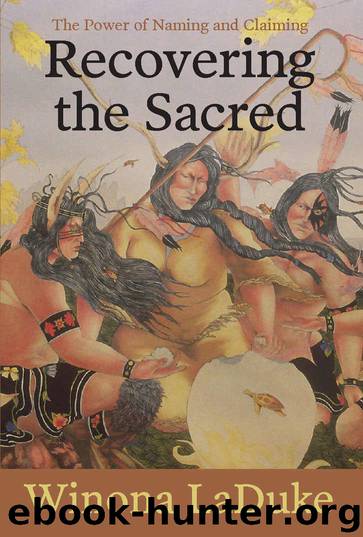Recovering the Sacred by LaDuke Winona

Author:LaDuke, Winona
Language: eng
Format: epub
ISBN: 978-1-6084-6662-7
Publisher: Haymarket Books
Published: 2016-04-10T16:00:00+00:00
Monocultures of the Mind and of the Land
Jubilant as those celebrations might have been, 200 years later it is perhaps possible that another change will come and justice may be served. As it turns out, the state of New York took possession of the vast majority of 64,000 acres of Cayuga territory through an agreement known as the Cayuga Ferry Treaty of 1795, five years after the federal Non-Intercourse Act of 1790 had barred states from signing treaties with Indian nations. The last of the tribe’s land was ceded in 1807. The agreements were “decidedly shady,” in the words of the New York Times and, it appears, even caused some unease in President Washington.12 “The state of New York knew exactly how illegal their actions were,” surmises Rossen. “They never intended to send them to Congress for ratification. They knew they were illegal. It was really a question of state versus federal power.”13
The Cayugas are the only Iroquois nation without a reservation, made refugees in their own land. For generations, the Cayuga families who had survived the “ethnic cleansing,” in the words of Cayuga leader Clinton Halftone, continued their dream of return to their traditional lands. Halftone, appointed by the clan mothers to forward the political and legal case for the return of the Cayuga land, explains the original goals of the Cayuga’s 1980 lawsuit against the state of New York: “When we filed in the 1980s, we sought return of the 64,000 acres that is ours, and $350 million in trespass damages.”14 Four years later, a panel recommended that the Cayugas should be given 8,000 acres in Cayuga and Seneca counties for a reservation and a cash settlement of $15 million. The land to be returned to the Cayugas was publicly owned; no private landholders would have been impacted.
The Cayugas were intent on making some agreement, but the proposed settlement was met with a bitter outcry by a group of non-Native landholders, calling themselves the Upstate Citizens for Equality. Formed in 1997 specifically as a “voice for those who face displacement,” its Seneca-Cayuga chapter has 4,000 members.15 In a 1984 New York Times article, reporter Michael Winerip captured the sentiments of the settlement opponents, reporting that non-Native people complained at public meeting that they didn’t want their children going to school with “dirty Indians suffering from dysentery and head lice.”16 When the lawsuit still remained unsettled in 1992, the federal government joined on behalf of the Cayugas. Two years later, Judge Neal McCurn ruled that the tribe indeed had a legal claim to 64,000 acres of land because Congress had never approved the acquisition of the land by the state, as required by the federal law. In 1999, the court-appointed mediator proposed a settlement in the range of $125 million to be split between the federal and state governments. The Cayugas accepted the settlement, but the state, fueled by the Upstate Citizens for Equality and other interests, would not agree, and instead pushed on through the appeals process.
Cayuga claims
Download
This site does not store any files on its server. We only index and link to content provided by other sites. Please contact the content providers to delete copyright contents if any and email us, we'll remove relevant links or contents immediately.
The Lonely City by Olivia Laing(4568)
Animal Frequency by Melissa Alvarez(4148)
All Creatures Great and Small by James Herriot(3986)
Walking by Henry David Thoreau(3681)
Exit West by Mohsin Hamid(3634)
Origin Story: A Big History of Everything by David Christian(3472)
COSMOS by Carl Sagan(3346)
How to Read Water: Clues and Patterns from Puddles to the Sea (Natural Navigation) by Tristan Gooley(3239)
Hedgerow by John Wright(3106)
How to Do Nothing by Jenny Odell(3101)
The Inner Life of Animals by Peter Wohlleben(3099)
How to Read Nature by Tristan Gooley(3077)
Project Animal Farm: An Accidental Journey into the Secret World of Farming and the Truth About Our Food by Sonia Faruqi(3018)
Origin Story by David Christian(2991)
Water by Ian Miller(2950)
A Forest Journey by John Perlin(2915)
The Plant Messiah by Carlos Magdalena(2745)
A Wilder Time by William E. Glassley(2689)
Forests: A Very Short Introduction by Jaboury Ghazoul(2671)
